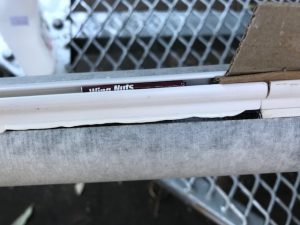- This topic has 0 replies, 1 voice, and was last updated 3 years, 1 month ago by .
-
Topic
-
The mast track can easily be damaged when lowering the mast and sometimes in the process of raising or lowering the mainsail.
The white PVC track is made by a New Zealand company, C-Tech, and it is available from Weta dealers. C-tech recommended that damaged track be replaced in lengths no shorter than 30cm (1ft) as smaller lengths are susceptible to being knocked off. The track is available in 3m lengths and to replace the entire track you will need 6m – 2m for the bottom section of mast and 4m for the top.
The adhesive used to stick it to the mast has to be strong and flexible but not so strong that you can’t remove it if you need to make a future repair. Epoxy glues are not recommended as most are not flexible enough. And the flexible versions (e.g. G/Flex) are really difficult to remove if you ever have to replace the track. See recommend adhesives below.
Process
Mark a section of old track at least 30cm long.Cut the ends of the section with a hacksaw being careful not to penetrate the resin coating on the mast – best to finish off the cut with a knife to avoid damaging the mast.
Slide the blade of the knife or paint scraper under the track to be removed and gradually prise the old track free taking the glue with it if you can (since it makes it easier to clean the site). Use a razor blade or similar to scrape any residual glue from the old track location and rub down with 400Gsm Wet & Dry paper to create a rough surface that the glue can adhere too.
Cut a section of new track to fit the new segment ensuring that it will fit flush to the mast without gaps to the next section of track. Round off the corners of the track at the joins with wet & dry to avoid snagging the sail track when hoisting the sail.
IMPORTANT: Use the wet & dry paper to roughen the back of the track to help the glue to grip.
Clean all surfaces with acetone or methylated spirits before applying adhesive.
Use masking tape to mask off the area on the mast where the new glue is going to be placed taking care to seal the edges. Prepare some rolled up paper or cardboard to align the new track with the existing track and once applied put some tape over it to hold it in place while curing.
Use the gun (and a steady hand) to squirt adhesive onto the area to be glued. The adhesive profile should be higher in the middle to help create a good seal when the new track is placed on the mast.
Place the new track segment on the glue and ensure it lines up with the next segment with the cardboard in the track. Also ensure the top of the new segment lines up with the old track and tape it into position with some masking tape.
When the adhesive is still curing, use a piece of scrap card to smooth out the excess and fill any gaps.
When cured, use a sharp blade to trim any excess adhesive and lift the masking tape to remove it.
You need to use a flexible adhesive that can withstand exposure to moisture – marine adhesive/sealants are always more expensive than non-marine versions.
Sikaflex-291 Marine Adhesive Sealant
Fixtech FIX 15
Sellys Marine Flex
3m 5200 (Fast Cure)If you find that the sail is pulling out of the foot of the track (especially using the SQ sail) then consider inserting a 30cm section of alloy track used in the 29er. Details here
- You must be logged in to reply to this topic.







